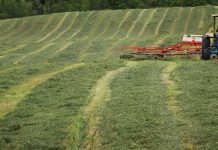There are the East and West coasts and then there is the Midwest. We’d like to think that not everything that hits the coasts is going to filter inland to the Heartland, but in many cases it does. Case in point, California’s Prop. 2 and its animal care edicts.
Right now, however, California is embroiled in another hot issue that also affects agriculture, as well as everyday living — an issue that will affects us all sooner or later. Water.
Water wars in the dry West are nothing new. After all, virtually all of this nation was settled and developed based on water availability.
But that geographic limitation is blurred ever since we harnessed the power of irrigation in agriculture. The United Nations report that irrigated surfaces equaled 198 million acres in 1950 — and 667 million acres as of 2000.
It’s said Mark Twain once observed, “Whiskey is for drinking; water is for fighting over.” Indeed, as a headline on a current news story proclaimed: “Water is the new oil.”
They’re finding that out in the San Joaquin Valley, which is California’s leading agricultural region and has sometimes been called the “nation’s salad bowl.” Fresno County alone accounted for $5.6 billion in ag production last year.
Farmers and residents there are facing two “biological opinions” governing California’s water flow. In a nutshell, the opinions are the basis for new environmental rules diverting 10 percent of the region’s irrigation water to the protection of the Chinook salmon and Central Valley steelhead instead.
And that’s on top of measures unveiled last December to protect the endangered delta smelt. The Fresno Bee reports that the cumulative effect of the water cuts — to agricultural users and the 25 million Californians who rely on the Sacramento-San Joaquin River Delta for drinking water — could be as much as 30 percent.
Thousands of farm acres have been left unplanted; unemployment in some farming communities is estimated at 40 to 50 percent, according to the California Farm Bureau. “State water deliveries to valley farms this summer will total only 30 percent of contract amount,” the state Farm Bureau reported earlier this spring, “while federal water deliveries for farmers south of the delta currently are at zero.”
The federal Interior Department has named a point person to deal with California’s water problems, and just this week, June 29, Gov. Arnold Schwarzenegger named his own state water czar.
“This is our new normal,” Westlands Water District spokesman Sarah Woolf recently told the Fresno Bee. She said Westlands, the largest agricultural user of delta water, is receiving just 10 percent of its federal water allotment this year.
Farmers in the Westlands district have fallowed more than 100,000 acres because of lack of water.
The reality is that the amount of water available for agriculture — and not only in California — is going to shrink.
“… reasonable uses may become unreasonable as the number of users of a water resource increases and the total quantity of water demanded surpasses supply.” Sound like a West Coast voice? It wasn’t. That came from an Ohio official explaining the state’s unpredictable water withdrawal law back in 2004.
Even the Midwest’s water abundance can’t be taken for granted. We need to think ahead to preserve and conserve this basic building block of life.













This water shortage is part of a larger world wide water shortage that requires nuclear power to solve. See Larouche.
http://www.google.com/search?hl=en&q=water+site%3Awww.larouchepub.com&btnG=Google+Search